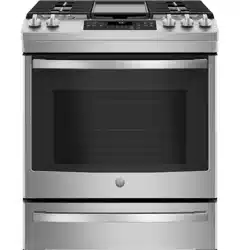Documents: Go to download!
- Owner's manual - (English, Spanish)
- USING THE RANGE
- CARE AND CLEANING
- TROUBLESHOOTING
Table of contents
Electric Slide-In Front-Control Convection Gas Range User Manual
USING THE RANGE
SURFACE BURNER
Lighting a Surface Burner
WARNING Burners should be operated only when covered by cookware. Burner flames not covered by cookware present a risk of fire or clothing ignition. Never let flames extend beyond the sides of the cookware. Failure to comply may result in serious injury.
Make sure all burners are in their correct locations and fully assembled before attempting to operate any burner.Select a burner are and find its control knob. Push the knob in and turn it to the LITE position.
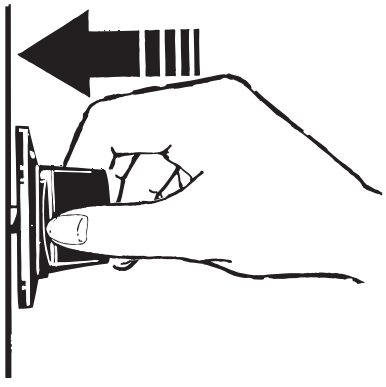
You will hear a clicking noise - the sound of the electric spark igniting the burner. When one burner is turned to LITE, all burners will spark. Sparking will continue as long as the knob remains at LITE. Once gas is ignited, turn the knob to adjust the flame size.
Selecting a Flame Size Watch the flame, not the knob, as you adjust heat. When rapid heating is desired, the flame size should match the size of the cookware you are using. Flames larger than the bottom of the cookware will not heat faster and may be hazardous. |

These flames are too large for the pot
Using the Surface Burners
NOTES:
- Do not operate the burner for an extended period of time without cookware on the grate. The finish on the grate may discolor or chip without cookware to absorb the heat.
- Do not attempt to disassemble any burner while another burner is on. Damage to the product may occur.
- Be sure the burner and grates are cool before you place your hand, a pot holder or cleaning materials on them.
Your rangetop has sealed gas burners that offer convenience, cleanability and flexibility for a wide range of cooking applications.
The smallest burner is the simmer burner. A simmer burner turned down to LO provides precise cooking performance for foods such as delicate sauces that require low heat for a long cooking time.
The extra-large burner is designed to quickly bring large amounts of liquid to a boil. Some models have a POWER BOIL™ setting especially designed for use with cookware with a diameter of 11inches or larger.
Types of Surface Burners

Tri-Ring Burner (some models)
| For large cookware, activate all rings by setting set the burner between Hi and Med. | For small cookware or low heating applications, only activate the inner rings by setting the burner between Lo and Sim. |
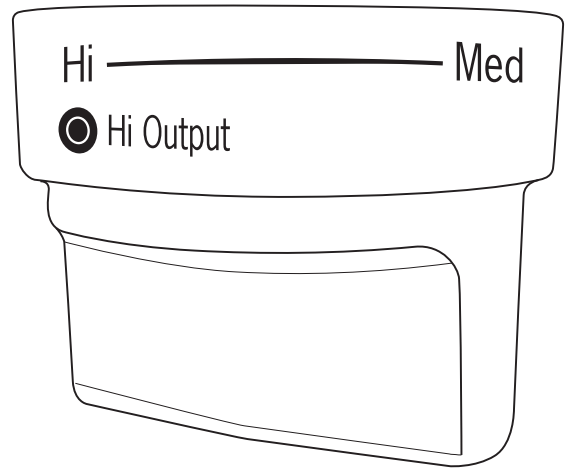 | 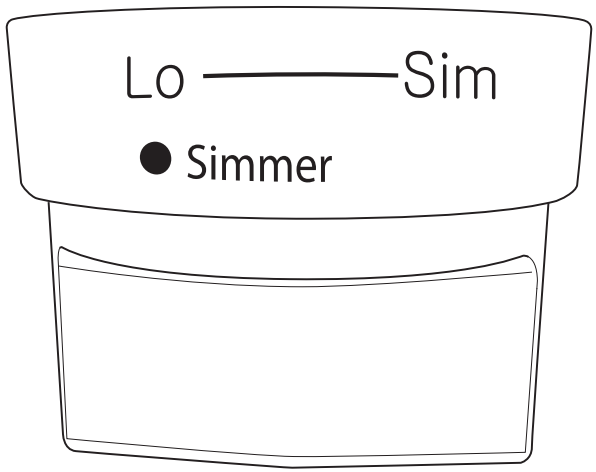 |
Side View Of The Tri-Ring Burner Knob | |
Dual Oval Burner (some models)
| For small cookware, only activate the round burner. | When using a griddle, activate both the oval and round burner sections. |
 | 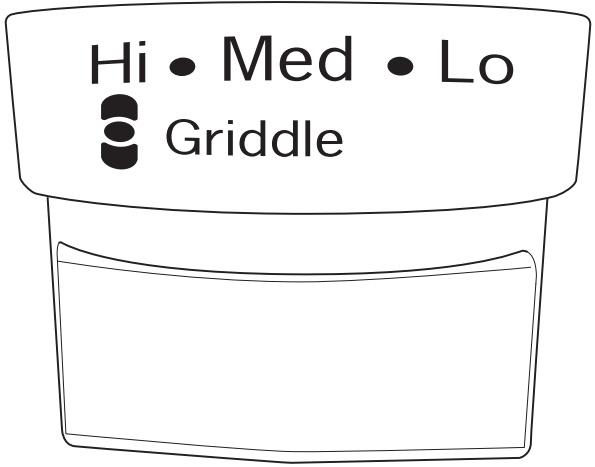 |
Side View Of The Dual Oval Burner Knob | |
Top-of-Range Cookware
Aluminum: Medium-weight cookware is recommended because it heats quickly and evenly. Most foods brown evenly in an aluminum skillet. Use saucepans with tight-fitting lids when cooking with minimum amounts of water.
Stainless Steel: This metal alone has poor heating properties and is usually combined with copper, aluminum or other metals for improved heat distribution. Combination metal skillets usually work satisfactorily if they are used with medium heat or as the manufacturer recommends.
Cast-Iron: If heated slowly, most skillets will give satisfactory results.
Enamelware: Under some conditions, the enamel of some cookware may melt. Follow the cookware manufacturer’s recommendations for cooking methods.
Glass: There are two types of glass cookware for oven use only and those for top-of-range cooking oven use only and those for top-of-range cooking (saucepans, coffee and teapots). Glass conducts heat very slowly.
Heatproof Glass Ceramic: Can be used for either surface or oven cooking. It conducts heat very slowly and cools very slowly. Check the cookware manufacturer’s directions to be sure it can be used on gas ranges.
Stove Top Grills
Do not use an after-market stove top grill on your gas surface burners. A stove top grill will cause incomplete combustion resulting in carbon monoxide levels above allowable standards. This could be hazardous to your health.

Do not use stove top grills
Using a Wok
- Use only a flat-bottomed wok with a diameter of 14 inches or less. Make sure the wok bottom sits flat on the grate.
- Do not use a wok support ring. placing the ring over the burner or grate may cause the burner to work improperly, resulting in carbon monoxide levels above allowable standards. This could be hazardous to your health.

Use a flat-bottomed wok
OVEN CONTROL
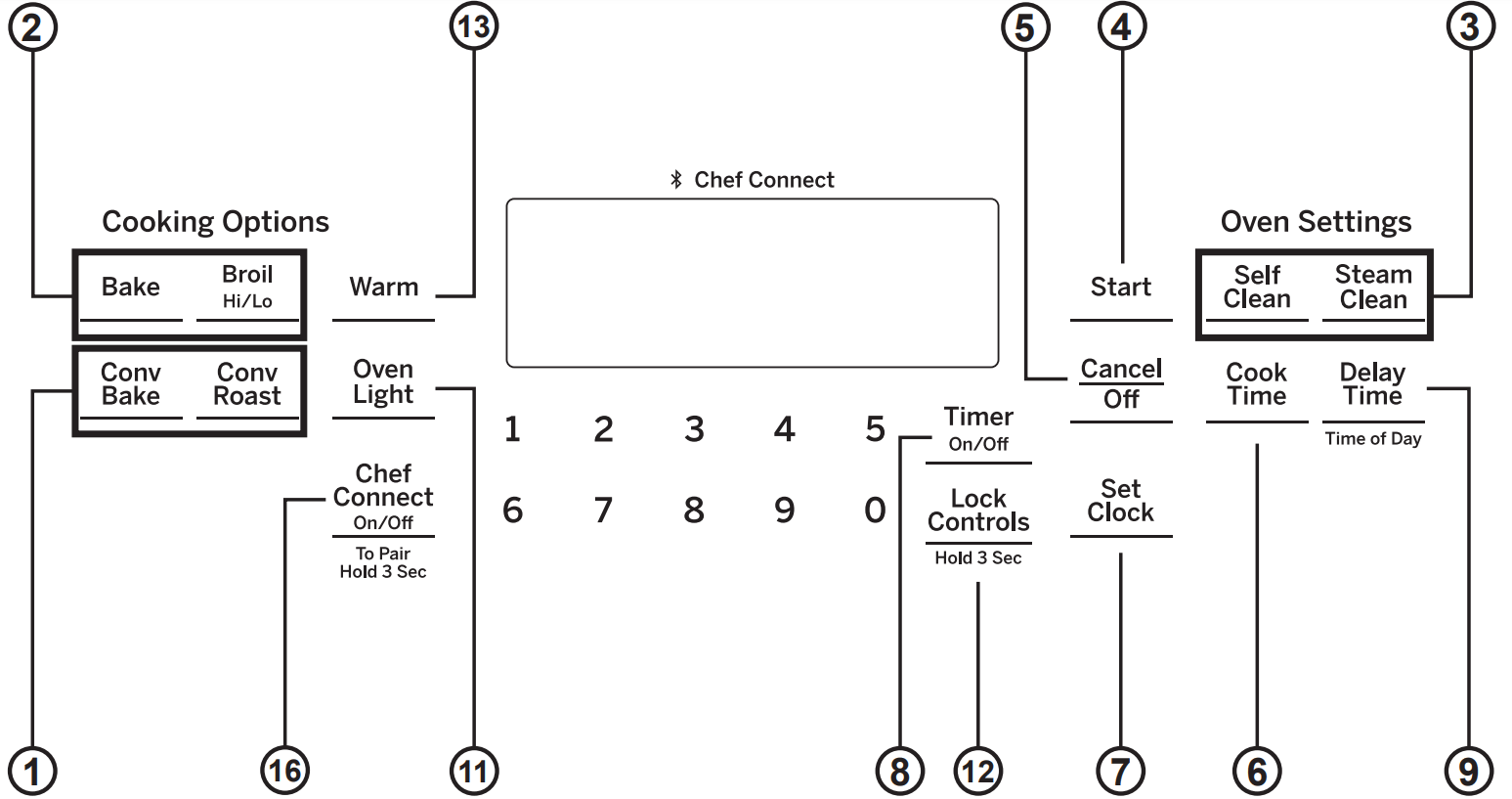
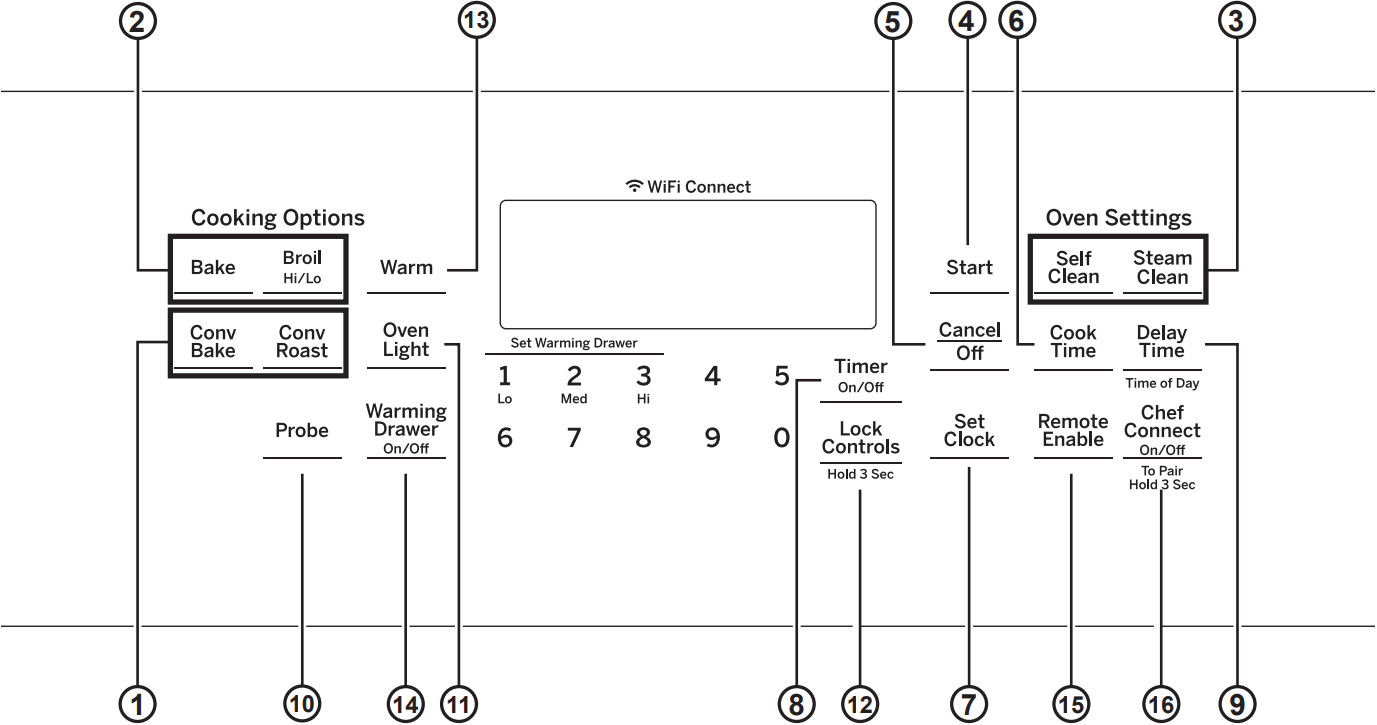
- Convection Cooking Modes: Convection cooking modes use increased air circulation to improve performance. The type of benefit depends on the mode. Your oven has the following convection cooking modes: Bake and Roast.
- Traditional Cooking Modes: Your oven has the following traditional cooking modes: Bake, Broil Hi, and Broil Lo. See the Cooking Modes section for more information.
- Clean: Your oven may have two cleaning modes:Self-clean or Steam clean (convection models).
- Start: Must be pressed to start any cooking, cleaning, or timed function.
- Cancel/Off: Cancels ALL oven operations except the clock and timer.
- Cook Time: Counts down cooking time and turns off the oven when the cooking time is complete.Pregram the desired cooking mode and cooking temperature, then press the Cook TimeSDG8VH the number pads to program a cooking time in hours and minutes, then press Start. This can only be used with Traditional Bake, Convection Bake, and Convection Roast.
- Clock: Set oven clock time. Press the Set Clock pad. Use the number pads to program the clock. Press Start to save the time.
- Timer: Works as a countdown timer. Press Timer pad and the number pads to program the time in hours and minutes. Press the Start pad. The oven will continue to operate when the timer countdown is complete. To turn the timer off press the Timer pad.
- Delay Time: Delays when the oven will turn on. Use this to set a time when you want the oven to start. Program the desired cooking mode and cooking temperature, then press the Delay Time pad. Use the number pads to program the time of day for the oven to turn on, then press Start. A cook time may also be programmed if desired. This can only be used with Traditional Bake, Convection Bake, Convection Roast, and Self Clean. Note: Foods that spoil easily-such as milk, eggs, fish, stuffings, poultry and port-should not be allowed to sit for more than 1 hour before or after cooking. Room temperature promotes the growth of harmful bacteria. Be sure that the oven light is off, because heat from the bulb will speed harmful bacteria growth.
- Probe (on some models): Monitors internal food temperature and turns the oven off when the food reaches the programmed temperature. Insert the probe, program the cooking mode, and program the probe ttemperature.
- Oven Light: Turns the oven light on or off.
- Lock Controls: Locks out the control so that pressing any pad does not activate the controls. Press and hold the Lock Controls pad for three seconds to lock or unlock the control. Cancel/Off is always active, even when the control is locked.
- Warm: Will keep hot, cooked foods at serving temperature. Press the Warm pad, then press Start. Push Cancel/Off to turn off the oven.
- Warming Drawer: Will keep hot, cooked foods at serving temperature. Press Warming Drawer pad. Use the number pads to select temperature setting. Press 1 for Low, 2 for Medium, or 3 forHigh, then press Start. Push Warming Drawer On/Off to turn off the warming drawer.
- Remote Enable (on some models): Allows you to control your oven remotely. To be able to start the oven remotely, press the Remote Enable pad, and “Remote” will be lit in the display. The oven can now be remotely started with a connected device. This appliance is configurable to allow remote operation at any time. Do not store any flammable materials or temperature sensitive items inside, on top or near the surface units of the appliance. If “Remote” is not shown in the display, you are still able to change the oven settings or turn the oven off. After using the oven, remember to verify that the “Remote” icon is displayed if you wish to start the oven remotely in the future.
- Chef Connect: This is a Bluetooth® pairing feature for use with other compatible Chef Connect enabled products like an over- the-range microwave oven or range hood. To pair those products to the range, press and hold the Chef Connect pad for 3 seconds and follow the corresponding instructions included with the mating Chef Connect enabled product if needed. The range will cancel pairing mode after two minutes if no mating device is detected.
COOKING GUIDE
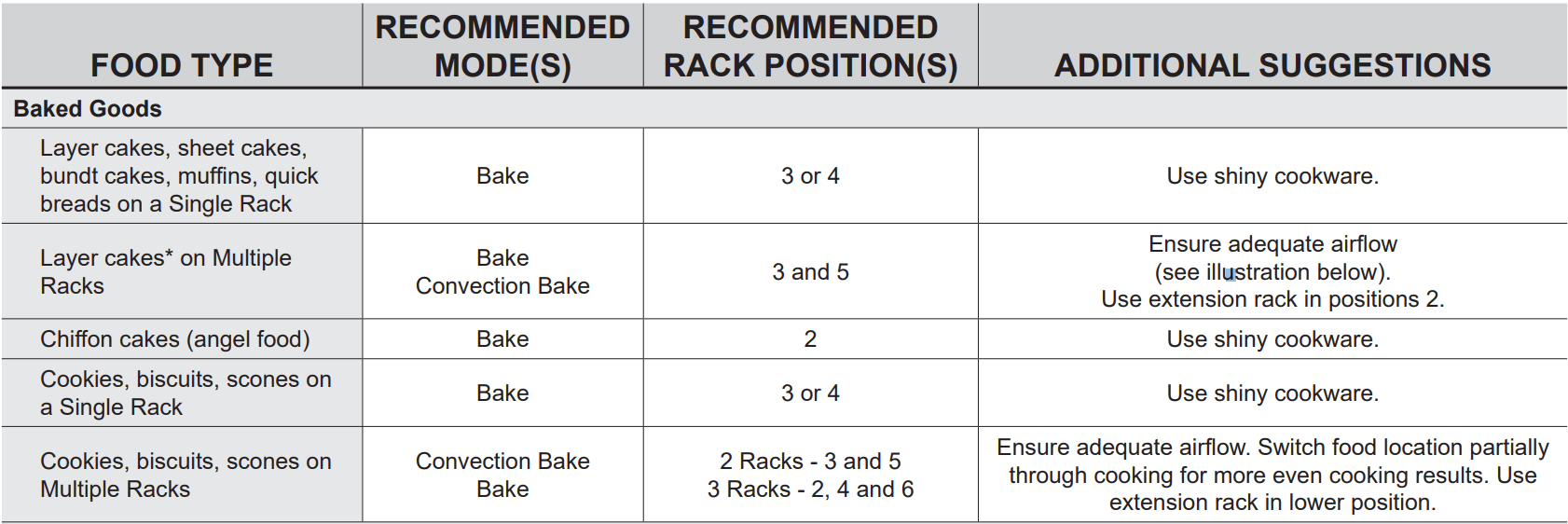



*When baking four cake layers at a time, stagger the pans as shown to the right so that one pan is not directly above another.
Cook food thoroughly to help protect against foodborne illness. Minimum safe food temperature recommendations for food safety can be found at IsItDoneYet.gov. Make sure to use a food thermometer to take food temperatures.
NOTE: Remove unused racks when using the oven for faster preheat, improved efficiency and optimal cooking performance.
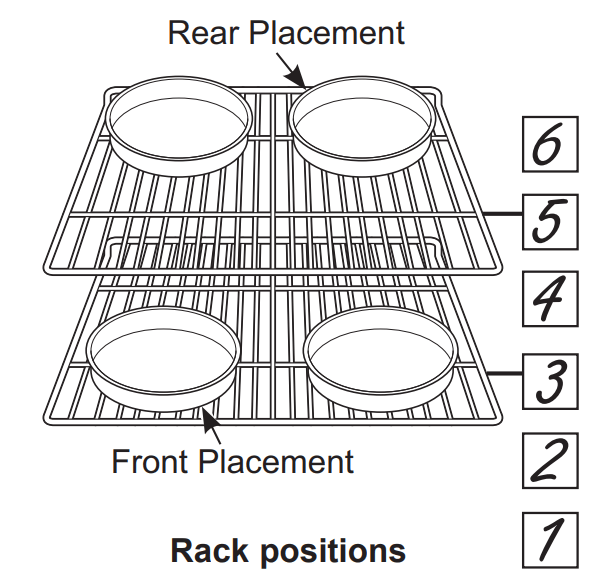
COOKWARE GUILDELINES
The material, finish, and size of cookware affect baking performance.
- Dark, coated and dull pans absorb heat more than light, shiny pans. Pans that absorb heat more readily can result in a browner, crisper, and thicker crust.
- If using dark and coated cookware check food earlier than minimum cook time. If undesirable results are obtained with this type of cookware consider reducing oven temperature by 25° F next time.
- Shiny pans can produce more evenly cooked baked goods such as cakes and cookies.
- Glass and ceramic pans heat slowly but retain heat well. These types of pans work well for dishes such as pies and custards.
- Air insulated pans heat slowly and can reduce bottom browning.
- Keep cookware clean to promote even heating.
- Stoneware heats slowly and retains heat well. It is recommended to preheat this type of cookware if possible. Additional cook time may be required.
COOKING MODES
Bake
The bake mode is for baking and roasting. When preparing baked goods such as cakes, cookies and pastries, always preheat the oven first. To use this mode press the Bake pad, enter a temperature with the number pads, and then press Start.
Warm/Warming Drawer (on some models)
Warm mode is designed to keep hot foods hot. Cover foods that need to remain moist and do not cover foods the should be crisp. Preheating is not required. Do not use warm to heat cold food other than crisping crackers, chips or dry cereal. It is also recommended that food not be kept warm for more than 2 hours. See the Oven Controls section for more information.
Some models may also have warming drawers. Three settings are available - use High for items such as stews, meats, and potatoes; use Medium for items such as casseroles and pizzas; use Low for items such as breads, waffles, and also for warming oven-safe dishes.
Broiling Modes
Always broil with the oven door/drawer closed. Monitor food closely while broiling. Use caution when broiling placing food close to the broil element or burner increases smoking, spattering and the possibility of fats igniting. It is not necessary to preheat when using the Broil modes.
Broil Hi
The Broil High mode uses intense heat from the upper element or burner to sear foods. Use Broil High for thinner cuts of meat and/or when you would like to have e a seared surface and rare interior. To use this mode press the Broil pad once and then press Start.
Broil Lo
The Broil Low mode uses less intense heat from the upper element or burner to cook food thoroughly while also browning the surface. use Broil Low for thicker cuts of meat and/or foods that you would like cooked all the way through. To use this mode press the Broil pad twice and then press Start.
Convection Bake
The Convection Bake mode is intended for baking on multiple racks at the same time. This mode uses air movement from the convection fan to enhance cooking evenness. Your oven is equipped with Auto
Recipe Conversion, so it is not necessary to adjust the temperature when using this mode. Baking times may be slightly longer for multiple racks than what would be expected for a single rack. To use this mode press the Conv Bake pad, enter a temperature with number pads, and then press Start. Always preheat when using this mode.
Convection Roast
The Convection Roast mode is intended for roasting whole cuts of meat on a single rack. This mode uses air movement from the convection fan to improve browning and reduce cooking time. Check food earlier than the recipe suggested time when using this mode, or use the probe. It is not necessary to preheat when using this mode.
To use this mode press the Conv Roast pad, enter a temperature with the number pads, and then press Start. It is not necessary to preheat when using this mode.
WIFI CONNECT
Connecting your WiFi Connect Enabled oven (on some models)
Your GE Appliances oven is designed to provide you with two-way communication between your appliance and smart device. By using the WiFi Connect features, you will be able to control essential oven operations such as temperature settings, timers and cooking modes using your smartphone or tablet.*
What you will need
Your GE Appliances oven uses your existing home WiFi network to communicate between the appliance and your smart device. In order to setup your GE Appliances oven, you will need to gather some information:
1. Each GE Appliances oven has a connected appliance information label that includes an Appliance Network Name and Password. 2 details that you will need to connect to the appliance. The label is typically located inside the door of the oven or drawer.

Sample label
2. Have your smart phone or tablet ready with the ability to access the internet and download apps.
3. You will need to know the password of your home WiFi router. Have this password ready while you are setting up your GE Appliances oven.
Connect your GE Appliances oven
- Visit GEAppliances.com/connect to learn more about connected appliance features and to download the appropriate app.
- Follow the app onscreen instructions to connect your GE Appliances oven.
- Once the process is complete, the connection light located on your GE Appliances oven display will stay on solid and the app will confirm you are connected.
- If the connection light does not turn on or is blinking, follow the instructions on the app to reconnect.
Note that any changes or modifications to the remote enable device installed on this oven that are not expressly approved by the manufacturer could void the user’s authority to operate the equipment.
CARE AND CLEANING
Cleaning the Oven – Exterior
Control Lockout
If desired, the touch pads may be deactivated before cleaning..
- Clean up splatters with a damp cloth. You may also use a glass cleaner.
- Remove heavier soil with warm, soapy water. Do not use abrasives of any kind.
- Reactivate the touch pads after cleaning.
Control Panel
It’s a good idea to wipe the control panel after each use.
Clean with mild soap and water or vinegar and water, rinse with clean water and polish dry with a soft cloth.
Do not use abrasive cleansers, strong liquid cleansers, plastic scouring pads or oven cleaners on the control panel-they will damage the finish, including Black Stainless Steel.
Oven Exterior
Do not use oven cleaners liquid cleansers, abrasive cleansers, strong liquid cleansers, steel wool, plastic scouring pads, or cleaning powders on the interior or exterior of the oven.
Clean with a mild soap and water or vinegar and water solution. Rinse with clean water and dry with a soft cloth.
When cleaning surfaces, make sure that they are at room temperature and not in direct sunlight.
If stain on the door vent trim is persistent, use a mild abrasive cleaner and a sponge-scrubber for best results.
Spillage of marinades, fruit juices, tomato sauces and basting liquids containing acids may cause discoloration and should be wiped up immediately. Let hot surfaces cool, then clean and rinse.
Painted Surfaces
Painted surfaces include the sides of the range and the door, top of control panel and the drawer front. Clean these with soap and water or a vinegar and water solution.
Do not use commercial oven cleaners, cleaning powders, steel wood or harsh abrasives on any painted surface.
Stainless Steel excluding Black Stainless Steel (on some models)
Do not use steel wool pad; it will scratch the surface.
Cleaners with oxalic acid such as Bar Keepers Friend Soft Cleanser™ will remove surface rust, tarnish and small blemishes. Use only a liquid cleanser free of grit and rub in the direction of the brush lines with a damp, soft sponge.
To clean the stainless steel surface, use warm sudsy water or a stainless steel cleaner or polish. Always wipe the surface in the direction of the grain. Follow the cleaner instructions for cleaning the stainless steel surface.
To inquire about purchasing cleaning products including stainless steel appliance cleaner or polish, see the Accessories and Consumer Support sections at the end of this manual.
Cleaning The Oven - Interior
Manual Cleaning
Do not use oven cleaners, strong liquid cleansers, steel wool, or scouring pads on the interior of the oven. For soils on the oven bottom and other enameled surfaces, use a gentle abrasive containing oxalic acid, such as Bar Keepers Friend®, with a non-scratch sponge. Take care not to apply any abrasive cleaners or sponges to the door glass, as it will scratch the reflective coating.
The oven interior and door glass may be cleaned using a soft cloth with a mild soap and water, or vinegar and water solution. After cleaning, rinse with clean water and dry with a soft cloth.
Self Clean Mode
Self Clean uses very high temperatures to clean the oven interior. For a moderately soiled oven, run a hour self-clean cycle. For a heavily soiled oven, run a 3 hour self-clean cycle. Only self-clean (black) racks and grates may remain in the oven during the self-clean cycle. All other items, including nickel plated (silver) racks, should be removed. If nicke lplated (silver) racks are left in the oven during a self-clean cycle, the racks will tarnish. If either type of rack is left in the oven during a self-clean cycle, the rack may become difficult to slide.
IMPORTANT: The health of some birds is extremely sensitive to the fumes given off during the self-cleaning cycle of any range. Move birds to another well- ventilated room.
To use the Self Clean feature:
1. Start with the oven at room temperature.
2. Wipe excess grease and soils from the oven and interior door.
3. Remove all items other the self-clean (black) racks and grates, if desired.
4. Close the door.
5. Press Self Clean pad and then press Start.
- You cannot open the door during the self-clean cycle.
- The door will remain locked after the self-clean cycle until the oven cools below the unlocking temperature.
- At the end of the self-clean cycle, allow the oven to cool and wipe any ash out of the oven.
Racks
All racks can be washed with warm, soapy water.
Racks may be more difficult to slide, especially after a self-clean. Put some vegetable oil on a soft cloth or paper towel and rub onto the left and right edges.
Probe (on some models)
The temperature probe may be cleaned with soap and water or a soap-filled scouring pad. Cool the temperature probe before cleaning. Scour stubborn spots with a soap- filled scouring pad, rinse and dry.
- Do not immerse the temperature probe in water.
- Do not store the temperature probe in the oven.
- Do not leave the temperature probe inside the oven during a self or steam clean cycle.

Cleaning Cooktop
Removal of Surface Burners for Cleaning
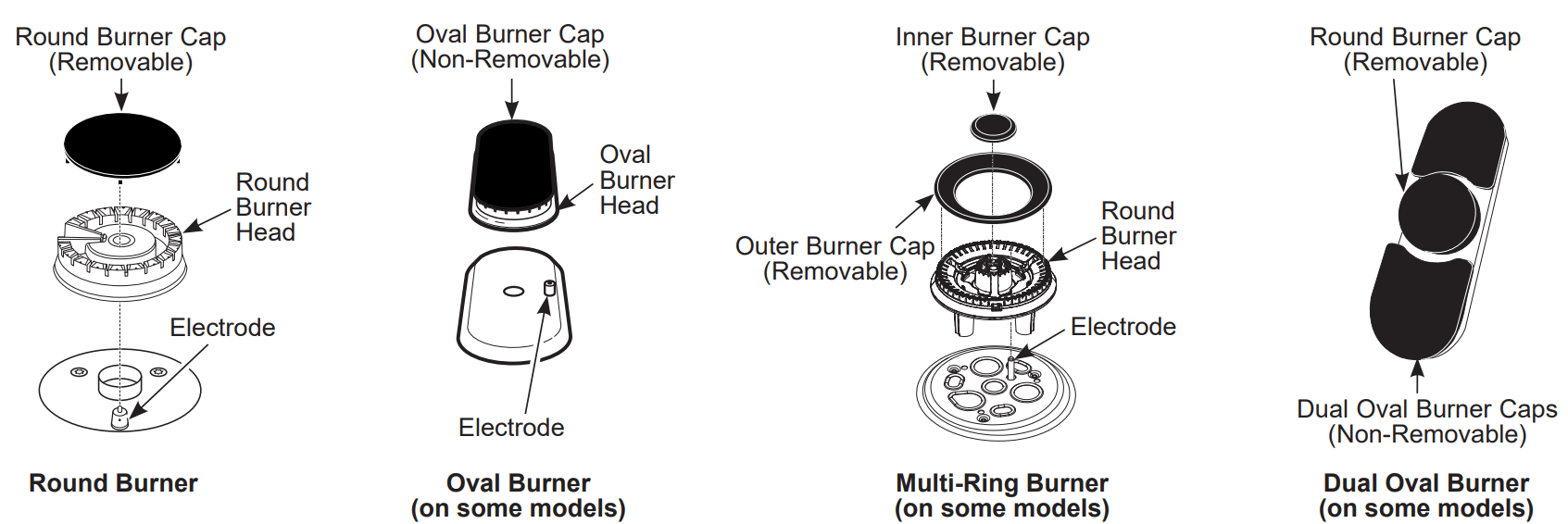
Cleaning the Surface Burners
Cleaning the Burner Caps
Wash burner caps in hot, soapy water and rinse with clean water. You may scour with a plastic scouring pad to remove burned-on food particles. The round burner caps may also be cleaned in your dishwasher.
Cleaning the Burner Heads
Wash the burner heads routinely, especially after bad spillovers which could clog the burner openings. Lift burners off when cool. Wash with hot, soapy water. Rinse with clean water. For more stubborn stains, use a brush with plastic bristles.
NOTE:
- Do not use steel wool or scouring pads to clean the burner parts as these may clog the openings. Never wash burner heads in your dishwasher as dishwasher. Doing so may cause them to discolor.
- The ports in the burner heads must be kept clean at all times for an even, unhampered flame.
- Clogged or dirty burner ports or electrodes will not allow the burner to operate properly.
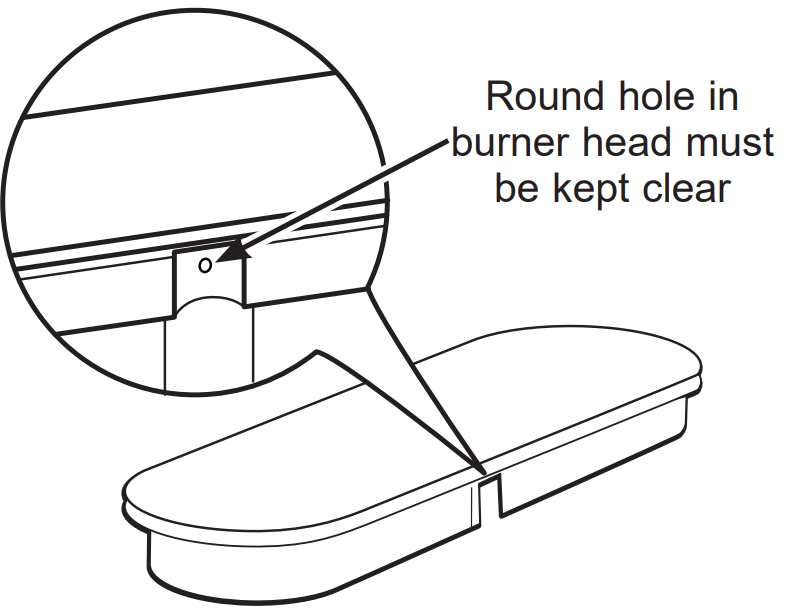
For proper ignition, make sure the small hole in the notch that fits over the electrode is kept open. A sewing needle or wire twist-tie works well to unclog it.
Replacing Surface Burners
Before replacing the burner caps, heads and oval head/cap assembly, shake out excess water and allow them to dry thoroughly.
Replace burner heads in the correct locations according to size. Ensure each cap is properly seated on the burner head, as pictured below.

CAUTION Do not operate the cooktop without all burner parts and grates in place. Any spill on or around an electrode must be carefully cleaned. Avoid hitting the electrode with anything hard or it could be damaged.
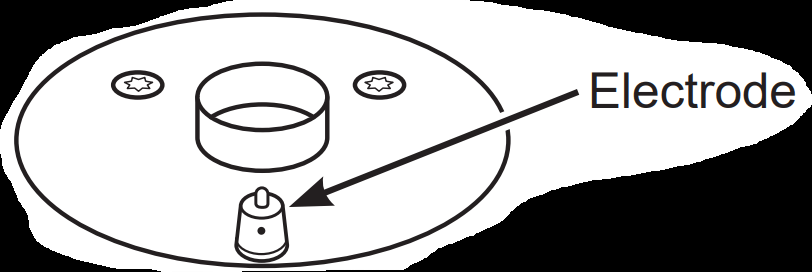
Burner Grates
Manual Cleaning
Grates should be washed in hot, soapy water and rinsed with clean water. To soften burned-on food, place grates in a solution containing 1⁄4-cup of household ammonia for several hours. Afterward, scrub grates with a plastic scouring pad soaked in hot, soapy water. Rinse well and dry.
Self Clean Mode (on some models)
If your grates do not have rubber bumpers on their bottom surface, they may be cleaned in the oven using the self-clean cycle. Do not attempt to clean your grates in the oven if your grates have rubber bumpers. Doing so will destroy the rubber bumpers and may affect the function of your surface burners.
Porcelain coated grates may gradually dull if continually exposed to self-clean temperatures.
If your oven is equipped with self-clean (black) racks, it is recommended to follow the instructions for placing grates on racks.
If your oven is equipped with nickel-plated (silver) racks, it is recommended to follow the instructions for placing grates on the oven bottom.
Nickel-plated racks should not remain in the oven during the self clean cycle. Doing so will tarnish the racks. If either type of rack is left in the oven during a self-clean cycle, the rack may become difficult to slide.
NOTE: When placing or removing grates from the oven, do not slide the grates on the racks or oven bottom. Doing so could damage the enamel on the racks or oven bottom.
To self-clean your grates on self-clean racks:
- Insert racks in position 1,3, and 5 or positions 2 and 4.
- Gently place one grate on each rack.
To self clean your grates on the oven bottom:
- Remove all oven racks.
- Gently place one grate on the center of the oven bottom with the grate oriented in the upright position. Stack remaining grates(s) as shown below. Do not place or stack grates in any other configuration.
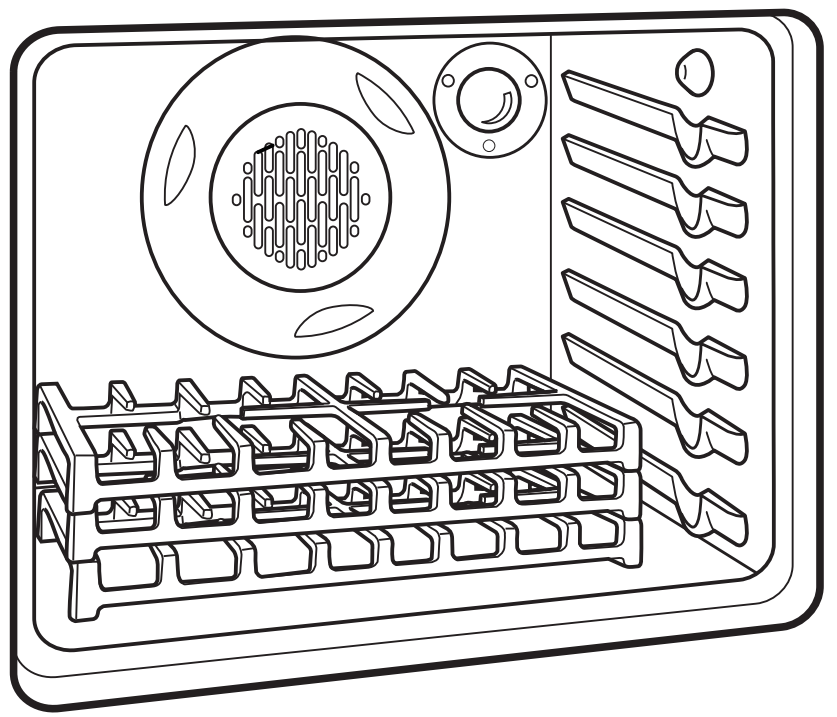
Once the grates are placed in the oven, operate the self- clean cycle per the instruction in the Cleaning the Oven section.
NOTE:
- Use caution when removing the grates from the oven after the self-clean cycle has ended. The grates may still be hot.
- Once the self-clean cycle is complete, the grates may carefully be removed. You may notice a white residue on the grates. Wipe it off with a damp sponge. If white spots persist, wet the sponge with a 50/50 solution of vinegar and water and wipe the grates again.
- When replacing the grates on the cooktop, be sure to locate them correctly. Grates should fit securely into the cooktop.
Grate Support Bumpers (on some models)
If any of the rubber grate support bumpers in the cooktop are missing or damaged, replace.
To insert the new bumpers, simply place the cone- shaped end of the bumper into the hole in the cooktop and push down while gently twisting the bumper.
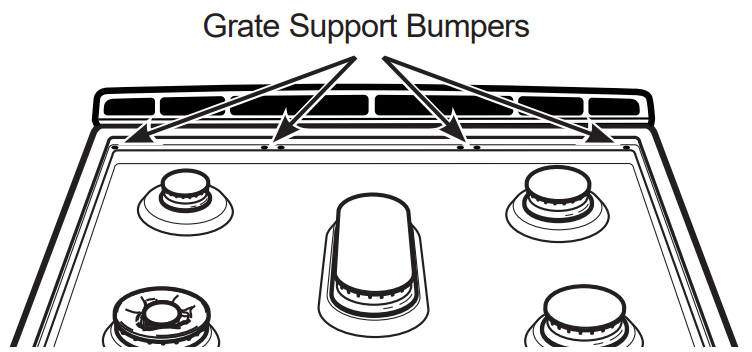
Griddles (on some models)
Nonstick Aluminum Griddle: Avoid scraping the griddle surface with metal utensils. Wash your griddle with dish soap and hot water. If necessary, scrub with a non-abrasive plastic pad.
Reversible Cast-Iron:
- Clean your reversible cast-iron griddle with a stiff brush and hot water. Using soap is not recommended, and harsh detergents should never be used as they will remove the seasoning. Rinse with hot water and dry thoroughly.
- After rinsing, preseason the griddle by applying a light coat of cooking oil to the griddle surface.
- Wipe off excess oil with a paper towel.
- Store in a cool, dry place.
Griddle Precautions:
- If something has spilled under the griddle, it should be cleaned up as soon as possible to prevent the spill from getting baked onto the cooktop.
- Do not allow grease to accumulate under the griddle as it can be a fire hazard. Clean under the griddle with hot, soapy water as soon as it is cool.
- Do not wash your griddle in the dishwasher.
- Do not clean the griddle in the self-cleaning ovens.
Door and Drawer
Removable Storage Drawer (on some models)
The storage drawer is a good place to store cookware and bakeware. Do not store plastics or flammable material in the drawer.
The storage drawer may be removed for cleaning under the range. Clean the storage drawer with a damp cloth or sponge. Never use harsh abrasives or scouring pads.
Your storage drawer may have plastic slides (shown to the right( or metal rails. Follow the respective removal and replacement instructions for your model’s configuration.
Removing the Storage Drawer:
- Pull drawer straight out until it stops
- Continue to pull the drawer until it is detached from the oven.
Replacing the Storage Drawer:
- Rest the left drawer rail around the inner left rail guide and slide it in slightly.
- Place the right drawer rail around the inner right rail guide and slide it in slightly.
- Slide the drawer all the way in.
Removable Warming Drawer (on some models)
NOTE: For models with an electric warming drawer, before performing any adjustments, cleaning or service, disconnect the range electrical power supply at the household distribution panel by removing the fuse or switching off the circuit breaker. Make sure the warming drawer heating element is cool.
Most cleaning can be done with the drawer in place. However, the drawer may be removed if further cleaning is needed. Use soap and warm water to thoroughly clean.
To remove the drawer:
- Pull drawer straight out until it stops
- Press the left rail release up and press the right rail release down, while pulling the drawer forward and free.
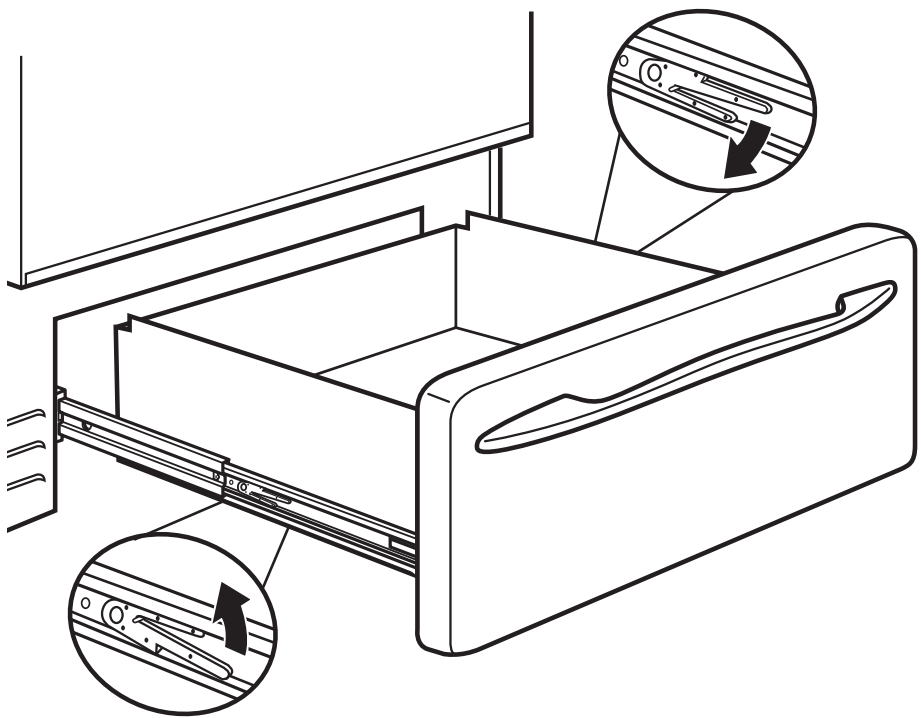
To replace the drawer:
- Place the left drawer rail around the inner left rail guide and slide it in slightly to hook it.
- Place the right drawer rail around the inner right rail guide and slide it in slightly to hook it.
- Slide the drawer all the way in.
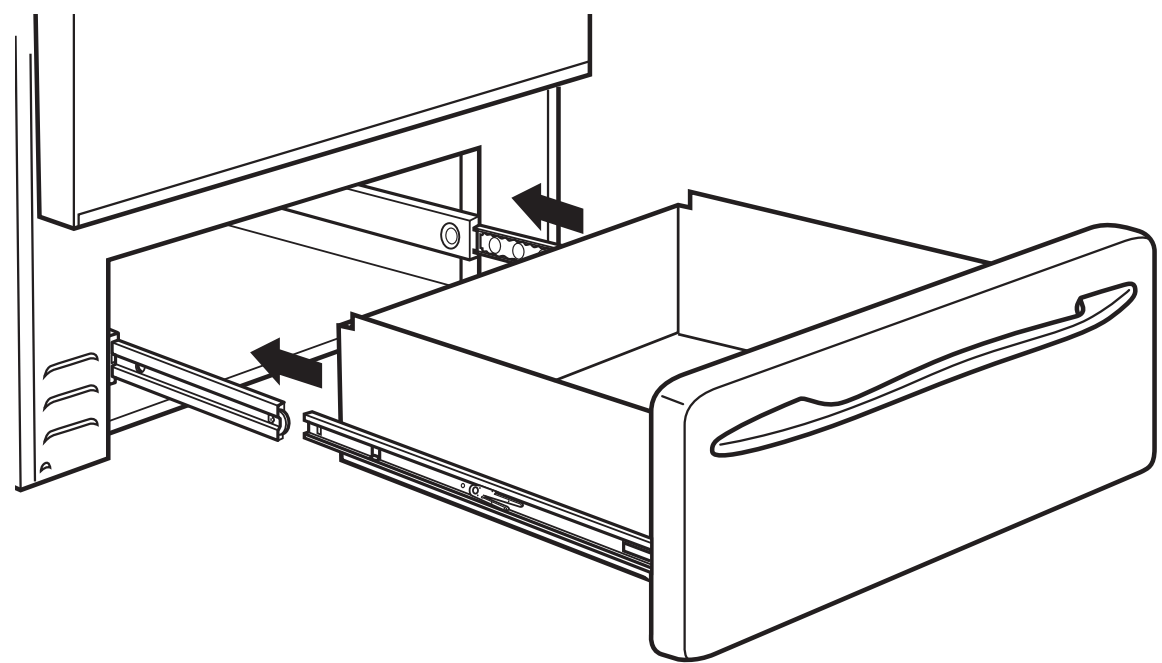
Oven Light
WARNING
SHOCK OR BURN HAZARD: Before replacing oven light bulb, disconnect the electrical power to the range at the main fuse or circuit breaker panel. Failure to do so may result in electric shock or burn.
CAUTION
BURN HAZARD: The glass cover and bulb should be removed when cool. Touching hot glass with bare hands or a damp cloth can cause burns.
Oven Light Replacement
To Remove:
- Turn the glass cover counterclockwise ¼ turn until the tabs of the glass cover clear the grooves of the socket and pull the cover off. Remove the bulb.
To replace:
- Put a new 40-watt appliance bulb. Place the tabs of the glass cover into the grooves of the socket. Turn the glass cover clockwise ¼ turn
NOTE:
- A 40-watt appliance bulb is smaller than a standard 40-watt household bulb.
- Reconnect electrical power to the oven once the new bulb is installed.
- For improved lighting inside the oven, clean the glass cover frequently using a wet cloth. This should be done when the oven is completely cool.
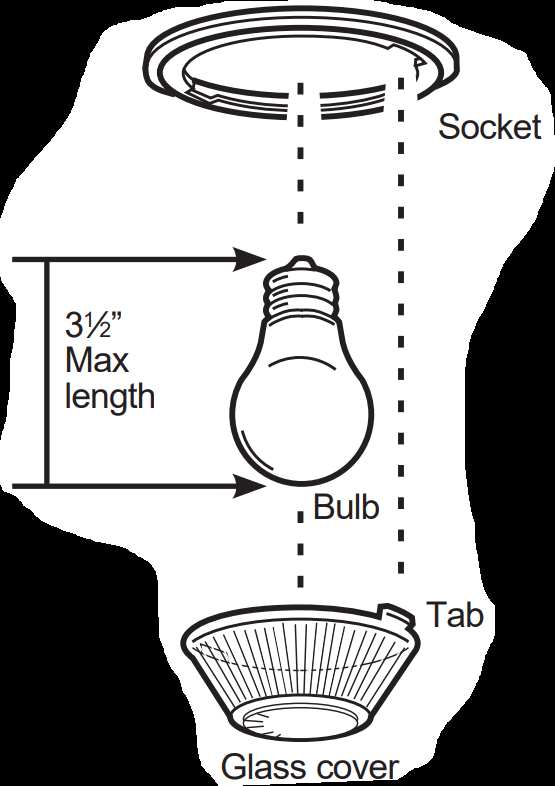
TROUBLESHOOTING
Problem | Possible Cause | What To Do |
|---|---|---|
| My new oven doesn't cook like my old one. Is something wrong with the temperature settings? | Your new oven has a different cooking system from your old oven and therefore may cook differently than your old oven. | For the first few uses, follow your recipe times and temperatures carefully and use rack positions recommended in the Cooking Guide. If you still think your new oven is too hot or too cold, you can adjust the temperature yourself to meet your specific cooking preference. See the Special Features section. |
| Food does not bake properly | Oven controls improperly set. | See the Cooking Modes section. |
| Rack position is incorrect or rack is not level. | See the Cooking Modes section and Cooking Guide. | |
| Incorrect cookware or cookware of improper size being used. | See the Cookware section. | |
| Oven temperature needs adjustment. | See the Special Features section. | |
| Food does not broil properly | Oven controls improperly set. | Make sure you select the appropriate broil mode. |
| Improper rack position being used. | See Cooking Guide for rack location suggestions. | |
| Cookware not suited for broiling. | Use a pan specifically designed for broiling. | |
| Aluminum foil on the broil pan has not been fitted properly or slit to drain grease. | If using aluminum foil on broil pan, wrap tightly and add slits conforming to those in the pan to allow grease to drain. | |
| Oven temperature too hot or too cold | Oven temperature needs adjustment. | See the Special Features section. |
| Oven and/or display appears not to work | A fuse in your home may be blown or the circuit breaker tripped. | Replace the fuse or reset the circuit breaker. |
| Oven controls improperly set. | See the Using the Oven section. | |
| Oven is in Sabbath Mode. | Verify, that the oven is not in Sabbath Mode. See the Special Features section. | |
| The clock is turned off. | See the Special Features section. | |
| “Crackling” or “popping” sound | This is the sound of the metal heating and cooling during both the cooking and cleaning functions. | This is normal. |
| Why is my range making a "clicking" noise when using my oven? | Your range has been designed to maintain a tighter control over your oven's temperature. You may hear your oven's heating elements "click" on and off more frequently than in older ovens to achieve better results during baking, broiling, and self-clean cycles. | This is normal. |
| Sometimes the oven takes longer to preheat to the same temperature | Cookware, food, and/or number of racks in oven. | Cookware, food, and racks in the oven will cause differences in preheat times. Remove excess items to reduce preheat time. |
| Oven light does not work | Light bulb is loose or defective. | Tighten or replace bulb. See the Maintenance section for instructions on how to replace the bulb. |
|---|---|---|
| Oven will not self-clean | The temperature is too high to set a self-clean operation. | Allow the oven to cool and reset the controls. |
| Oven controls improperly set. | See the Cleaning the Oven section. | |
| Excessive smoking during clean cycle | Excessive soil or grease. | Press the Cancel/Off pad. Open the windows to rid the room of smoke. Wait until the LOCKED light goes off. Wipe up the excess soil and reset the clean cycle. |
| Oven not clean after a clean cycle | Oven controls improperly set. | See the Cleaning the Oven section. |
| Oven was heavily soiled. | Clean up heavy spillovers before starting the clean cycle. Heavily soiled ovens may need to self-clean again or for a longer period of time. | |
| Strong “burning” or “oily” odor emitting from the vent | This is normal in a new oven and will disappear in time. | To speed the process, set a self-clean cycle for a minimum of 3 hours. See the Cleaning the Oven section. This is temporary. |
| Excessive smoking during broiling | Food too close to burner element. | Lower the rack position of the food. |
| Oven door will not open or LOCKED light is on when you want to cook. | The oven door is locked because the temperature inside the oven has not dropped below the locking temperature. | Press the Cancel/Off pad. Allow the oven to cool below the locking temperature. |
| "LOCK DOOR" flashes in the display | The self-clean cycle has been selected but the door is not closed. | Close the oven door. |
| “F— and a number or letter” flash in the display | You have a function error code. | Press the Cancel/Off pad. Allow the oven to cool for one hour. Put the oven back into operation. If the function code repeats, disconnect all power to the oven for at least 30 seconds and then reconnect power. If the function error code repeats again, call for service. |
| Power outage, clock flashes | Power outage or surge | Reset the clock. If the oven was in use, you must reset it by pressing the Cancel/Off pad, setting the clock and resetting any cooking function. |
| Lock Controls or Control Lockout feature is activated | If LOC ON appears in the display, the range control is locked. Turn this feature off to use the range. See the Lock Control feature in the Oven Controls section. | |
| Burners do not light | Plug on range is not completely inserted in the electrical outlet. | Make sure electrical plug is plugged into a live, properly grounded outlet. |
| Gas supply not connected or turned on. | See the Installation Instructions that came with your range. | |
| A fuse in your home may be blown or the circuit breaker tripped. | Replace the fuse or reset the circuit breaker. | |
| Burner parts not replaced correctly. | See the Care and Cleaning of the range section. | |
| Burner slots near the electrode, or the round lighter port on the oval burner, may be clogged. | Remove the burners and clean them. Check the electrode area for burned-on food or grease. See the Care and Cleaning of the range section. | |
| Food residue on electrode | Lightly polish flat tip of electrode with nail file or sandpaper until shiny. |
| Top burners do not burn evenly | Improper burner assembly. | Make sure the burner caps are seated correctly. See the Care and Cleaning of the range section. |
|---|---|---|
| Burner slots on the side of the burner may be clogged. | Remove the burners for cleaning. See the Care and Cleaning of the range section. | |
| Burner flames are very large or yellow | Improper air to gas ratio. | If range is connected to Propane gas, contact the technician who installed your range or made the conversion. |
| Surface burners light but bake and broil burners do not. | Gas to the oven burners may have been shut off. |
The oven gas shut-off is located on the gas re gulator near the gas line attachment to your range. Locate it and flip the lever. Lever is shown closed.  |
| My oven door glass appears to be "tinted" or have a "rainbow" color. | The inner oven glass is coated with a heat barrier to reflect the heat back into the oven to prevent heat loss and keep the outer door cool while baking. | This is normal. Under certain light or angles, you may see this tint or rainbow color. |
| Drawer does not slide smoothly or drags | The drawer is out of alignment. | Fully extend the drawer and push it all the way in. See the Care and Cleaning of the range section. |
| Drawer is over-loaded or load is unbalanced. | Reduce weight or redistribute drawer contents. |
See other models: GMR02BANDWW ZIPP360NHBSS HTR15ABMELCC JGBP28BEH2CT JGB900BEK7BB
